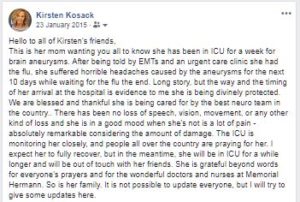
Hello Everyone!
I’m Kirsten’s mom. I live with Kirsten and was with her in January, 2015 while she was waiting 10 days for the “flu” to end as instructed by EMTs and an urgent care clinic; was in the NICU with her for 14 days during treatment of the rupture; with her during the first year post rupture, when before fully recovered, two other aneurysms, unruptured, were treated – one with craniotomy, requiring a long, hard recovery period.
I’ve learned a lot and hopefully can eventually share some things that might be helpful to someone. Right now, though, I can’t think of anything more important to mention than how totally unprepared I was to deal with any of the stages – pre-rupture, rupture & hospitalization, and recovery.
Had I known more about aneurysms and possible rupture symptoms, I would have insisted she go to the emergency room instead of letting her insist I quit mentioning it. And, had she known, she would have wanted to go to the emergency room right away herself.
To have survived those nine days of the leaking aneurysm before full rupture, the wait in the ER while locating a hospital with an available room, the 40-minute ambulance ride to the med center, the drivers not knowing where to find the correct entrance to the NICU, rupturing and seizing when transferring from cot to bed — requiring emergency intubation… means she arrived at the hospital without a moment to spare. Some aren’t as fortunate. Education and awareness will help lessen the numbers of those who are not.
I need to mention that when on that 9th day she decided it was time to go to the emergency room, I actually did not call an ambulance, but drove — drove to the nearest hospital which turned out not to be a hospital anymore; then drove to the next closest, but didn’t know exactly which exit off the freeway it was located. Embarrassing and scary to think back on that. I now know the importance of calling an ambulance and of knowing the location and fastest route to the closest hospital.
When back home from the 13-day hospital stay and reading, I learned more about what had happened to her and how it could affect her physically, mentally, and emotionally. My first reaction was to make very sure she didn’t learn about this stuff, but I found her busy googling, too. Of course, everyone in the family needs to be educated – including the patient.
Fortunately, Kirsten’s deficits are very mild and noticeable only to her and her neurologist, but had she been correctly diagnosed and received treatment earlier – before full rupture, the brain trauma might have been lessened. More awareness of aneurysm rupture or leaking symptoms is needed; obviously, not all EMTs or Urgent Care clinics are fully educated.
Because aneurysm rupture is so often sudden and deadly, without any warning, it’s my opinion that testing should be routinely available and offered, especially for those with risk factors. Medical bills for treatment of a rupture are huge; living with resulting severe disabilities is expensive and devasting to the whole family. So much better, and less expensive, to find and treat an aneurysm before rupture, if possible.
Spreading awareness is now a passion and a privilege for both of us. No agony, pain, distress, or difficulty should be wasted, right?
Phyl

